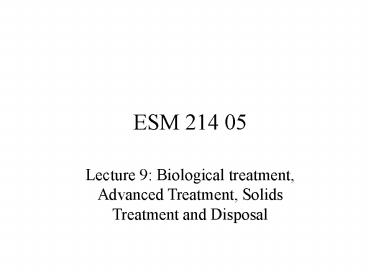ESM 214 05 - PowerPoint PPT Presentation
1 / 20
Title:
ESM 214 05
Description:
Similar configurations to activated sludge, aerobic reactors, but ... Meatpacking. Distilleries. Municipal waste. Anaerobic WastewaterTreatment: Considerations ... – PowerPoint PPT presentation
Number of Views:57
Avg rating:3.0/5.0
Title: ESM 214 05
1
ESM 214 05
Lecture 9 Biological treatment, Advanced
Treatment, Solids Treatment and Disposal
2
Anaerobic WastewaterTreatment
- Similar configurations to activated sludge,
aerobic reactors, but no oxygen. - Used more with industrial wastewaters
- Intermittent flows
- High COD
- Uses less energy, makes less sludge, makes CH4
(energy), but.. - Biomass grows slowly, acidifies, partial
treatment, no extra P or N removal
3
Anaerobic Wastewater Treatment
- Breweries
- Dairy and cheese production
- Fish processing
- Leachate treatment
- Pulp/paper
- Meatpacking
- Distilleries
- Municipal waste
4
Anaerobic WastewaterTreatmentConsiderations
- Mesophilic (25 to 35 C) conditions advantageous
- Long SRTs e.g. 20 days at 30 C
- May need to add CaCO3 to buffer
- May need to add nutrients
- Sensitive to
- Toxic metals and organics
- Ammonia
- Oxidized sulfur ---bacteria compete for COD
5
Anaerobic Lagoon generic
6
Anaerobic lagoon (ADI/BVF))
7
Microbiology of Anaerobic Treatment
- CO2 or organics are e- acceptors
- C is from CO2 or organic compounds
- Energy is from organic compounds or H2
- Y 0.05
- Slow growing bacteria
8
Conversions and operative groups of bacteria in
anaerobic digestion.
9
Anaerobic digester microbiology
- 1 extracellular hydrolysis (e.g. cellulase)
- 2 fermentation leading to organic acids (VFAs),
acetate, CO2 and H2 - 3 fermentation leading to acetic acid (CH3COOH),
H2 and O2 - 4 methanogenesis leading to CH4,CO2 and H2O
10
Anaerobic Digester
11
2 stage digestion
12
Methanogenesis
- By methanogens which are archaea
- By either
- Hydrogen utilizers (1/3)
- Acetate-splitters (2/3)
- pH sensitive (7 7.2)
- Slow relative to VFA production
- Lowers H2 which facilitates acetate formers
13
What happens in digestion?
- Stabilization
- Reduce pathogen content
- Reduce odors
- Complete VFA production and conversion
- Volatile solids reduction (about 60)
- Gas production (70 CH4, 30 CO2) (anaerobic only)
14
40 CFR Part 503 Biosolids Disposal
- Land application fertilizer (bulk or bagged)
- Surface disposal dedicated lagoons or other
sites - Pathogen and vector reduction
- Class A low pathogens and treatment choices
specified (nurseries, gardens, golf courses) - Class B lesser treatment (agriculture, landfill)
- incineration
15
Composting
- 30 VSS destruction
- Aerobic, mostly
- Pasteurization (50 to 70 C)
- Static pile 28 days then 30 day cure
- Windrow 30 days, 55 C
- In vessel
- Feed sludge solids 40
16
Composting
17
Windrow Composting
18
In vessel composting
19
Feed solids and ammendment
20
Advanced Treatment
- Better than secondary
- Filtration solids removal
- RO dissolved organics and inorganics
- Adsorption (e.g. GAC) organics
- Air Stripping volatile organics and ammonia
- Ion exchange dissolved nutrients































